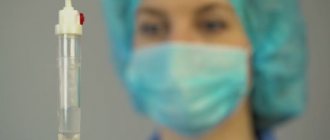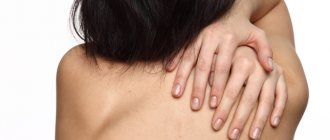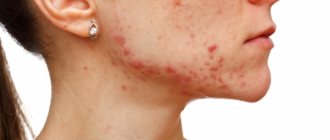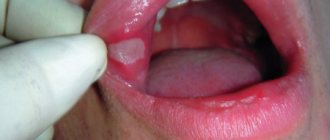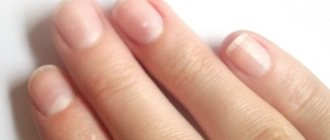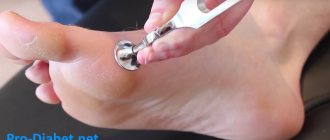WhatDiseases > Women's diseases > Vulvovaginitis > Dangers and treatment of vulvovaginitis in girls
Vulvovaginitis in girls is a common disease characterized by a combination of inflammation of the vaginal mucosa (vaginitis) and the external genitalia (vulvitis). The risk of developing infection is present in children from the first year of life until puberty. Therapy for vulvovaginitis, like other gynecological diseases, is complex and includes antibacterial, hormonal agents for local and oral use. It is difficult to treat inflammation in children, since the prescription of many drugs is limited by the child’s age.
Vulvovaginitis in girls
The problem of vulvitis in girls
Vulvitis is an inflammatory process affecting the area of the external genitalia (from the Latin vulva - a collective concept that unites all anatomical structures related to the external female genitalia).
Vaginitis is inflammation of the vaginal mucosa (lat. vagina).
The most common is a combined lesion of the vulva and vagina - vulvovaginitis, which occupies a leading position in the structure of gynecological diseases of childhood. Most often, girls are susceptible to the disease during the “neutral” period of sexual development - from one month to 8 - 9 years - which is explained by the functional immaturity of the genital organs, and, importantly, the insufficient activity of the immune system and endocrine glands at this age.
Diagnostic methods
To identify the causes of the disease, girls should make an appointment with a pediatric gynecologist. He carefully examines the perineum, external genitalia and vaginal area. Then the doctor takes a smear using swabs soaked in saline solution. In the laboratory, in addition to determining the causative agent of the infection, they conduct tests for their sensitivity to antibiotics.
The doctor also gives children a referral for clinical tests and ultrasound. If the inflammation has not affected the pelvic organs and is not associated with a viral infection, blood tests are normal. Leukocytes and bacteria are found in the urine throughout the entire field of view. In this case, you should check your kidneys and bladder with an ultrasound to rule out infection.
They also perform an analysis for enterobiasis. In some cases, it is not informative, so to clarify the diagnosis, blood is taken to test for parasitic infestations. In addition, children are advised to check their sugar levels. If specific inflammatory pathogens are suspected, it is necessary to donate blood for analysis using the PCR method.
Typically, treatment for vulvovaginitis begins before culture results are received, since this test takes several days to complete. Children are prescribed ointments and solutions for topical use. If therapy is ineffective, antibacterial agents are prescribed in the form of suspensions or tablets. Treatment of vulvovaginitis in girls, with rare exceptions, is carried out on an outpatient basis (at home).
Age characteristics of the genital organs of girls and adolescent girls
Children's genitals have a number of anatomical and physiological features that do not always allow them to adequately resist the infectious process. Common features include:
- weak closure of the labia minora and majora in the posterior regions;
- the mucous membrane has a small number of folds;
- the epithelium of the reproductive tract is thinned, cell reproduction and renewal are slow;
- low level of humoral protection factors (interferons, etc.) in vaginal secretions;
- coccal flora predominates;
- The baby's vagina has a neutral or alkaline pH level.
Features of the microflora of the genital organs in girls, depending on age and hormonal levels, are reflected in Table 1.
The newborn period directly depends on the maternal hormones supplied to the baby through the placenta. The mother's estrogens stimulate the epithelial cells of the girl's vagina, which mature, become keratinized, accumulate glycogen, and, in general, function like those of an adult woman. The vagina is populated with lactoflora, which protects the mucous membranes from the proliferation of pathogens. Lactobacilli produce hydrogen peroxide, stimulate the formation of interferon and immunoglobulins, due to which vulvovaginitis practically does not occur in girls in the first three weeks of life.
The “neutral” period begins after the 20th day of life and lasts until 8–9 years. The level of maternal hormones decreases, the epithelium becomes thinner, lactobacilli disappear, the pH shifts (weakly alkaline or neutral), and the genital mucosa becomes populated with coccal and bacillary flora.
Beginning of puberty. On average, puberty begins at 9 years of age. The production of estrogens is triggered, under the influence of which the vaginal epithelium changes. The cells mature, glycogen accumulates in them, the mucous membrane is populated with lactobacilli, the pH shifts to the acidic side (slightly acidic reaction).
Adolescence. By age 13, estrogen levels continue to rise, approaching adult female levels. Stimulation of the epithelium by estrogen leads to its further maturation, the proliferation of lactobacilli, and the reaction of the environment is acidic.
Table 1
Composition of vaginal microflora and pH dynamics in children of different ages
| Age | Vaginal microflora | pH of the environment |
| First hours of life | sterile | |
| First day | coccal flora | |
| 2nd - 3rd day | predominance of lactobacilli, a small amount of coccal flora | sour |
| 20th day – 9 years | There are no lactobacilli, the flora is coccal-bacillary | neutral or slightly alkaline |
| 9 – 12 years | lactobacilli in small quantities | slightly acidic |
| over 12 years old | lactobacilli predominate | sour |
Types of vulvovaginitis
The classification of this disease is based on the etiology and clinical course of the disease.
Depending on the type of course, vulvovaginitis is distinguished:
- Acute (symptoms are well expressed and greatly bother the baby);
- Chronic (symptoms may not bother you for a long time; during remission the disease occurs in a latent form, during exacerbations the clinical picture is more vivid).
Depending on the causes of occurrence, vulvaginitis is distinguished:
- Fungal (mycotic), better known as thrush. It occurs due to damage to the mucous membrane by fungi of the genus Candida. The trigger point for the development of this type of disease most often is: the use of antibacterial agents without a doctor’s prescription, decreased body immunity, hypovitaminosis, endocrinological diseases (diabetes mellitus).
- Viral. It occurs as a result of damage to a small organism by various viruses (herpes, cytomegalovirus, adenovirus, etc.). Infection can occur even while the child is passing through the woman’s birth canal.
- Trichomonas. It can develop due to insufficient or incorrect adherence to the rules of personal hygiene, or the use of other people's hygiene items (soap, towel). In babies, infection can occur when passing through the mother's birth canal. In older children, infection can occur through sexual contact.
There are other types of this disease, but these are the most common types in children. Physiological predisposing factors for the development of the disease in children are low levels of estrogens, which ensure the maintenance of the acid-base balance of the vagina at the level of an acidic environment (3.8-4.5).
Also factors that can trigger the development of the disease are:
- Insufficient compliance with hygiene rules;
- Excessive hygiene and douching, which leads to irritation of the mucous membrane;
- Using soap for personal hygiene (changes the pH of the vaginal mucosa);
- Reduced immunity of the whole body;
- Hypothermia of the body;
- Promiscuity in older children.
The main pathogens and factors contributing to the development of vulvitis in girls
Of course, the anatomical and physiological features of the structure of the genital organs play a certain role in the development of inflammatory diseases, but everyone has them, but vulvitis and vulvovaginitis, fortunately, do not occur in all girls. What is the trigger for the development of inflammation? All factors can be divided into predisposing and causal.
Causal factors can be infectious or non-infectious.
Non-infectious factors
Non-infectious include:
- mechanical (injuries, foreign bodies, helminthic lesions);
- chemical (washing with concentrated solutions);
- thermal (hot water, overheating due to untimely changing of diapers);
- allergic lesions of the mucous membrane.
Infectious factors
Infectious factors:
- bacteria;
- viruses;
- fungi of the genus Candida.
It should be noted that it is infectious factors that play a leading role in the development of vulvitis and vulvovaginitis.
Inflammation in the area of the external genitalia, which begins as aseptic, soon becomes infectious due to the activation of opportunistic flora or the addition of pathogenic flora.
Bacteria, according to a number of authors, cause up to 75% of cases of vulvitis in girls in the “neutral” period. In this case, most often, with the help of laboratory tests, nonspecific flora is detected: Escherichia coli, staphylococci (aurus and/or epidermal), streptococci, enterococci, peptostreptococci, bacteroides. Specific pathogens (Trichomonas, chlamydia, urea and mycoplasma, etc.) are rare in children. Inflammatory processes caused by these pathogens require a special approach to diagnosis and treatment; we will omit their discussion for now.
In recent years, there has been an increase in the specific number of vulvitis caused by several pathogens at once (microbial associations), which forces specialists to reconsider approaches to treatment.
Viruses account for 10 to 25% of vulvovaginitis. Most often, herpetic lesions of the vulva occur in girls aged 1 to 6 years. Less commonly, inflammation can be caused by adenoviruses, paramyxoviruses, etc.
Vulvovaginal candidiasis in children before puberty is not common, usually due to a severe decrease in immunity and the use of antibiotics.
Predisposing factors
- failure to maintain genital hygiene or, conversely, excessive “washing” with soap (all beneficial flora is washed away);
- neglect of air baths in babies - the moist, warm environment in the diaper contributes to injury to the mucous membranes and the proliferation of microorganisms;
- tight synthetic underwear;
- a decrease in the body’s defenses due to a lack of vitamins and microelements in food due to an unbalanced diet;
- presence of chronic diseases;
- synechiae, congenital anomalies of the genital organs;
- problems with the digestive tract, intestinal dysbiosis.
Prevention
The main principle of preventive measures is compliance with the rules of intimate hygiene, proper care of the child’s body, and strengthening the girl’s general immunity. If you have already had vulvovaginitis, then you can avoid its recurrence by adhering to the following rules:
- Little girls need to change diapers and nappies on time;
- It is worth washing the perineum from front to back;
- Linen should be changed every day or morning and evening if there is a predisposition to pathology;
- You need to choose panties only from natural materials;
- When washing, it is necessary to use hypoallergenic powders and rinse clothes thoroughly;
- There is no need to wash yourself with soap every day;
- Avoid using intimate hygiene products with dyes and fragrances;
- Lead a healthy lifestyle and balance your diet.
These recommendations will help reduce the risk of vulvovaginitis in girls, even if such a pathology has never occurred before. If the disease has been treated, then after three months the child must be shown to a pediatric gynecologist who can assess the effectiveness of the treatment. Subsequently, you need to visit a doctor once a year.
Classification of inflammatory diseases of the vulva and vagina in girls
Depending on the duration of the inflammatory process and the degree of its severity, vulvovaginitis is divided into:
- acute – pronounced manifestations lasting up to 3 weeks;
- subacute – less severe symptoms, duration from three weeks to three months;
- chronic - a sluggish inflammatory process with periodic exacerbations that lasts more than 3 months.
Depending on the etiology of the disease, vulvovaginitis is divided into specific and nonspecific.
Specific vulvovaginitis includes trichomoniasis, chlamydia, gonorrhea, mycoplasmosis, candidiasis, genital tuberculosis, herpes, etc.
Nonspecific vulvovaginitis can be primary (foreign bodies, infectious agents, helminthic infestation, chemical, mechanical factors, bad habits) and secondary (allergic diseases, metabolic disorders, extragenital foci of chronic infectious processes, dysbacteriosis).
Complementary therapy
Sitz baths with a decoction of chamomile flowers or oak bark are shown. They should be prepared according to this recipe: pour a tablespoon of the medicinal plant with a glass of boiling water and leave for 2 - 3 hours. Then strain the solution and mix with previously prepared warm water. Instead of decoctions, you can use potassium permanganate diluted to a light pink color.
Symptoms of vulvovaginitis (itching, burning, vaginal discharge) cause anxiety and irritability in the child. Therefore, sedatives based on valerian or motherwort are indicated. To moisturize the mucous membrane, use peach or sea buckthorn oil. Vulvovaginitis usually develops against a background of weakened immunity. Therefore, it is necessary to undergo a course of treatment with drugs such as Neovir, Interferon, Immunal, Echinacea compositum.
Symptoms and complaints
Despite the variety of causes and factors contributing to the development of inflammation, acute vulvitis in girls has similar clinical manifestations.
Girls who can speak will complain of itching and burning in the genital area , pain when urinating , and discharge from the genital tract . Upon examination, a bright red, swollen vulva, discharge (leucorrhoea) from the genital tract of varying nature and intensity (scanty, moderate, copious, purulent, watery, sanguineous, etc.) are revealed. The inflammatory process may spread to the skin of the thighs, buttocks, and abdomen. The general condition rarely suffers; in the case of a severe course and lack of treatment, neurosis-like conditions may develop due to constant itching and lack of sleep.
In girls who cannot speak, vulvitis and vulvovaginitis become their mother’s “find.” Parents pay attention to changes in the child’s behavior , especially during urination; they may detect discharge on a diaper or panties , and when performing hygiene procedures, attention is drawn to the redness of the child’s labia, changed color of the mucous membranes and skin, and their swelling.
Depending on the age, vulvitis in a child has varying degrees of severity of clinical manifestations.
Maternal antibodies and estrogens promote “self-cleaning” of the vagina in newborn girls, so acute vulvitis is extremely rare in them.
In a state of “hormonal rest”, when there is no influence of estrogens, and the level of protective cells in the vagina is significantly reduced, the inflammatory process becomes more pronounced. The mucous membrane is swollen, hyperemic, often ulcerated, the affected area is extensive, and the process involves the skin of the labia, pubis, thighs, and perineum. Itching and burning tire the child, sleep is disturbed, and irritability appears.
During puberty, when the production of female sex hormones is activated, natural local protective mechanisms of the mucous membrane are formed, a self-cleaning mechanism is launched, vulvovaginitis occurs subacutely, with few symptoms. Swelling and hyperemia of the mucous membrane are mild, and the general condition is rarely affected.
What if you don’t go to the doctor, but treat yourself with home remedies as needed?
Acute vulvitis or vulvovaginitis usually goes away without a trace. If, of course, mom took timely and sufficient measures. If this is not done, the consequences can be very unpleasant.
- Acute vulvitis will turn into chronic, affecting the uterus and ovaries, and later, when the girl grows up, it will cause her problems with conception.
- Synechiae appears or progresses. The labia will become fused to such an extent that it becomes difficult to urinate. This will lead to an ascending infection of the bladder and kidneys. Treating urinary tract diseases is much more difficult, more expensive and takes longer.
- A focus of chronic infection will appear in the girl’s body, which will constantly reduce immunity. The child will fall into the category of constantly ill, which will slow down his physical and mental development.
Diagnosis of vulvitis and vulvovaginitis
Of course, in the case of an acute inflammatory process, even a person without a medical education needs only a glance to understand for sure that this is vulvitis (vulvovaginitis). The situation is worse in subacute or chronic cases, when most of the manifestations are smoothed out, and only an experienced specialist can recognize the signs of the inflammatory process. But no matter how acute the process is, it should be remembered that clinical manifestations do not allow one to reliably establish the cause, which means that without a thorough examination it will not be possible to prescribe adequate treatment.
Of course, the doctor, in order not to start the inflammatory process in the genital area and to alleviate the child’s condition, can prescribe treatment immediately, based on personal experience, and in most cases it will be effective. But! Tests still need to be taken. In a few days they will be ready, and then it will be possible to adjust the treatment if necessary.
Material should be collected for laboratory testing before starting the use of antibacterial (antiviral, antifungal) drugs.
Anamnesis
In order for the doctor to correctly determine the tactics for examining and treating a little patient, the mother will have to answer many questions. And don’t be surprised if a specialist suddenly starts asking about how the pregnancy, childbirth proceeded, what chronic diseases mom and dad have, what social conditions the child lives in - all this is extremely important for establishing the correct diagnosis. In addition, the mother will have to remember what the girl was sick with, what medications were taken, whether she had allergies, whether she had contact with infectious patients, and much more.
Inspection
After a thorough interview, the specialist will begin the examination. For vulvitis, not only the genitals of girls will be examined, but also the skin, oral mucosa, and eyes. The condition of the lymph nodes must be assessed and the abdomen palpated (palpated). During the examination of the genital organs, the doctor, with the consent of the mother, collects material for laboratory testing.
Laboratory diagnostic methods
Modern diagnostic methods make it easy to detect any pathogen. The doctor decides which method to resort to in a particular situation. To confirm the fact of inflammation and assess the vaginal microbiocenosis, a simple smear is sufficient. To identify the pathogen, a bacteriological examination of the genital tract discharge is necessary. Both of these methods are accessible, informative, and the analysis result is ready within a short time.
However, in some cases it is necessary to resort to more expensive and time-consuming diagnostic methods. For long-term, treatment-resistant vulvitis, flora and sensitivity to antibiotics are cultured. The disadvantage of this method is the long wait for results and the need for special conditions for the growth of microorganisms. Pros: reliable identification of the pathogen, indicating the drugs that are most harmful to it.
Polymerase chain reaction is considered the most informative method at the present stage. Allows you to establish an accurate diagnosis when detecting a small number of pathogens, sections of their cells, by completing (“cloning”) copies identical to those obtained from the material. The advantage of the method is high information content and relatively quick results. The disadvantage is the price.
In addition to a direct examination of the genital organs, to clarify the diagnosis, the doctor may prescribe additional methods - a urine test, a stool test for eggworms, a blood test (to detect antibodies to certain pathogens), and scraping from the conjunctiva of the eyes.
Very rarely, an instrumental examination method can be used - vaginoscopy - examination of the vagina and vaginal part of the cervix using optical instruments. They resort to it if it is not possible to identify the true cause of recurrent purulent discharge. With the help of vaginoscopy, it is possible to detect foreign bodies, tumors, and vaginal polyps. In children it is performed under general anesthesia.
Drug therapy
The list of prescribed medications depends on the causative agent of the disease. If no specific bacteria are identified, preference is given to drugs for topical use. This reduces the risk of systemic complications and side effects. For treatment of the vagina and external genitalia, children are shown:
- Levomekol contains the antibacterial component chloramphenicol, active against most representatives of gram-positive and gram-negative microflora, and methyluration, which accelerates the regeneration processes of the mucous membrane;
- Syntomycin liniment is similar in action to Levomekol, as it contains chloramphenicol;
- Miramistin solution is a powerful antiseptic with a bactericidal and fungicidal effect;
- Sangviritin solution 0.2% has a wide spectrum of action against pathogenic microflora.
When treating vulvovaginitis in girls, carefully lubricate the mucous membrane of the external genitalia with ointment. It is also possible to administer the drug to children into the vagina using a catheter (or a syringe without a needle). When prescribing solutions, moisten gauze folded in several layers and make lotions. The manipulation must be repeated 2–3 times a day.
The principles of treatment of specific childhood vulvovaginitis differ. After identifying the pathogen, an antibiotic is prescribed. Children are more often prescribed Augmentin. It is taken in the form of syrup, the dosage is 40 mg/kg. In case of severe infection, girls over one year of age are prescribed Azithromycin (Sumamed) in the amount of 10 mg/kg per day. If trichomoniasis is detected, Metronidazole is required; from one to 12 years of age, it is taken at a rate of 20 mg/kg in three doses.
Treatment of allergic vulvovaginitis in girls is carried out with antihistamines. They are given to children in the form of syrups. The range of medications in this group in tablets is much wider than in the form of suspensions. Doctors recommend Erius, Claritin, Clarisens (they are used starting from 1 year) 2.5 ml per day.
Treatment of vulvitis in girls
Treatment of vulvitis in girls is a complex multi-stage task that requires a differentiated approach. Since both the occurrence and development of the inflammatory process depends on the general condition of the body, in most cases local treatment alone is not enough. An integrated approach is needed with the correction of the body’s defenses and the rehabilitation of chronic foci of infection.
General treatment and hygiene
Maintaining personal hygiene can speed up the healing process. It is necessary to wash an infant girl every time she changes diapers with warm running water without soap. It is recommended to use soap for genital hygiene once a week.
Don't be confused! To cleanse the skin of the buttocks and perineum from feces, baby soap can be used after each bowel movement.
During treatment of vulvovaginitis, a girl older than one year (provided she refuses diapers) should be washed 3-4 times a day with warm water without soap, thoroughly cleansing the genitals of purulent discharge. During the treatment period, panties are changed after each wash. For healthy girls, a daily change of towel is recommended, but during treatment of vulvitis it is better to change the towel after each wash (it is more convenient to use during this period to dry the genitals after washing with baby diapers - they are easy to wash and dry quickly).
Wet wipes must NOT be used for genital hygiene during the treatment period! With their help, the infection can be “rubbed” into the injured mucosa even deeper.
General treatment includes sanitation of chronic foci of infection, treatment of concomitant acute infections (conjunctivitis, rhinitis, diarrhea, bronchitis, etc.), treatment of allergic reactions, as well as the prescription of vitamins and diet therapy. During the acute period of vulvovaginitis, it is recommended to limit carbohydrates, meat broths, spices, marinades and enrich the diet with vegetables and fruits.
Local therapy
Local treatment includes mechanical cleansing of mucous membranes from secretions using medicinal solutions (furacillin, hydrogen peroxide, rivanol, chlorhexidine) or decoctions and infusions of herbs, followed by application of anti-inflammatory ointments, creams, and liniments to the affected areas.
Medicinal herbs (chamomile, oak bark, calendula, string) can be used both for washing and for sitz baths. To obtain an effective medicinal concentration, herbs are brewed at the rate of 5 - 7 grams per 1 liter of water. Before immersing the affected area in the broth, remove the discharge by washing it under running water without soap. The duration of a sitz bath is no more than 5 minutes. If you leave the child in the bath for more than five minutes, the mucous membrane will become wet, and the pathogen can penetrate even deeper, i.e. such a procedure can complicate treatment rather than speed up recovery.
as ready-made local dosage forms for the treatment of nonspecific bacterial vulvovaginitis: Levomekol, synthomycin emulsion 5 - 10%, Dalatsin cream, Levasin. To treat candidal lesions, antifungal ointments and creams are used - clotrimazole, nystatin, miconazole; for the treatment of viral lesions - suppositories with interferon, acyclovir. If necessary, the doctor can write a prescription for the preparation of the medicine at the pharmacy.
Systemic drugs
When treating vulvovaginitis in childhood, systemic drugs are rarely used. This may be necessary in case of recurrent forms of nonspecific bacterial vaginitis; in case of severe herpetic lesions, local treatment is combined with oral administration of drugs to speed up the recovery process; in case of recurrent forms of vulvovaginal candidiasis.
But when treating specific bacterial lesions (chlamydia, mycoplasma, gonorrhea, etc.), systemic treatment is always indicated!
Traditional methods of treatment
Infusions and decoctions of medicinal herbs, which have already been described above, are used as traditional methods of treatment.
Causes of the disease
A change in the natural balance of microflora can provoke the development of an inflammatory process. The causative agents of the disease can be:
- bacteria;
- Trichomonas;
- viruses;
- chlamydia;
- staphylococci and streptococci;
- gonococci;
- yeast-like fungi of the genus Candida.
Unprotected sexual intercourse can cause vulvitis of a viral, gonococcal or trichomonas nature. A number of factors can lead to the development of a nonspecific or candidal process, namely:
- failure to properly observe the rules of intimate hygiene;
- cystitis;
- excess weight;
- uncontrolled or prolonged use of antibiotics;
- helminthiasis;
- leukemia;
- oral sex;
- endometritis, vaginitis;
- inflammation of the urinary system;
- diabetes;
- diseases that weaken the immune system: bronchitis, pneumonia, influenza;
- allergy;
- constant humidity combined with high temperature in which the genitals are located;
- folds of the vulva;
- increased tissue sensitivity;
- chemical or mechanical irritants. This may include douching with aggressive substances;
- use of thick synthetic underwear.
The disease tends to develop during periods when there is a high level of estrogen in the body, such as childhood, adolescence and menopause. The disease also often appears during pregnancy.
Itching on the labia with diabetes
As you probably know, diabetes cannot be completely eliminated. For this reason, people who are faced with a similar illness have to do everything so that it does not interfere with their normal life.
In view of this, if this pathology also manifests itself as itching in the labia area, then the sick woman simply needs to ensure that the acid balance of the skin in this area is always within normal limits.
To avoid itching in the labia area, follow these rules:
- Use a neutral pH cleanser
- Be sure to wash yourself 2 times a day
- Iron your laundry on both sides
- During your period, change your pad and tampon every 3 hours.
- Wear underwear made from natural fabrics
Traditional methods for relieving itching
In folk medicine, there are recipes that can relieve itching and redness:
- Mix 1 tablespoon of potassium parchment 2% in 1 liter of water. Wash the child with the solution.
- Chamomile baths relieve discomfort when walking and urinating. To do this, you need to pour 2 tablespoons of herbs into 1 liter of water, the mixture should boil and brew. The duration of the procedure is 20 minutes. Repeat several times a day.
- Oak bark is also used for baths.
Adhesive vulvitis
This type of disease is known to parents as synechiae. Due to insufficient functioning of the mucous membrane, the labia minora grow together (photos of the pathology are available on specialized forums). A similar phenomenon occurs in half of girls aged 1 to 2 years. In most cases, synechiae is physiological in nature and goes away on its own.
Sometimes the fusion of the labia interferes with normal urine flow and air exchange, leading to bacterial vulvovaginitis. Treatment consists of prescribing 1% hydrocortisine ointment to children. It is applied to the affected area twice a day for 2 weeks, then once a day for the same period. If such therapy does not have an effect, instrumental separation of the labia under anesthesia is indicated.
Itching on the labia with psoriasis
Typically, genital psoriasis manifests itself as pale pink, round papules in the area of the labia majora and minora. After some time, the dermis in these places becomes very dry and covered with light scales, which gradually fall off, thereby only increasing the itching and burning.
A fairly large number of women believe that if these scales are removed, the problem will go away on its own. In fact, in order to get rid of psoriasis, drug treatment alone is not enough. In this case, it is extremely important to adhere to proper nutrition and be sure to strictly monitor vulvar hygiene.
Means for the treatment of genital psoriasis:
- Tacrolimus
- Pimecrolimus
- Iclosporin
- Methotrexate
- Vitamin D
- Salt baths
- Washing with golden mustache tincture
Folk remedies
Due to the low level of trust in traditional medicine, a number of parents prefer to treat vulvitis in girls using folk remedies. Herbal and medicinal mixtures, ointments and tinctures based on them, various lotions and compresses - all this looks beautiful only in words.
Perhaps similar recipes used to help our great-great-grandmothers get rid of this disease, but too much has changed since then. The ecology has changed, turning a number of useful plants into carriers of a whole cocktail of chemical elements, people's knowledge in the field of medicine has changed (after all, while treating one thing, such a recipe could well cripple another), people have changed.
Moreover, using any prescriptions without first consulting a pediatrician, you risk provoking an allergic reaction in your child, the consequences of which can be disastrous.
To treat vulvitis in girls at home, baths with decoctions of medicines are used.
The main ones include:
- Chamomile decoction, this remedy has been known for a very long time as an anti-inflammatory drug that can relieve not only swelling and inflammation, but also, to a small extent, itching. It is prepared by steaming several tablespoons of the plant in boiled water; some recommend boiling the mixture in water for a short time or simply leaving it in a container, covered with a towel. After which the mixture is filtered. The resulting solution is used as sitz baths, so the effect is much faster, but it should be noted that the water should be at a comfortable warm temperature; the decoction should not be too cold or hot.
- Calendula decoction. A product that has similar properties, but has certain advantages. More often used for people with a tendency to allergic diseases. It is prepared in the same way as the previous one; you can use either a self-prepared plant or a ready-made one purchased at a pharmacy. Also used as baths or lotions.
- Oak bark extract. Used as a sitz bath and has an anti-inflammatory effect. To do this, pour boiling water over the dry mixture and cook for several minutes, then cool and strain. The duration of the procedure can be up to 30 minutes.
- If a candida cause of inflammation is established, then soda solutions are used to relieve symptoms and reduce the pathogenic properties of the pathogen. More often used as lotions. To do this, you need to prepare a solution of baking soda by mixing a tablespoon with 1 liter of clean boiled warm water.
Antibacterial drugs
To treat vulvovaginitis, your gynecologist may prescribe topical or systemic antibiotics. Systemic drugs are prescribed to children when the disease is already in an advanced stage or is acute.
For nonspecific vulvovaginitis, antibiotics with a broad spectrum of action are used. If the pathogen is accurately identified, the most preferable is to take narrowly targeted drugs. Vulvovaginal candidiasis involves the use of suppositories and ointments with an antifungal effect. These include:
- Miconazole (3% cream);
- Clotrimazole (vaginal tablets and 1% cream);
- Ticonazole (6.5% ointment).
Bacterial vulvovaginitis is treated with the following drugs:
- Pharmacological action of Metronidazole cream Metronidazole (tablets or gel);
- Clindamycin (tablets or 3% cream).
When vulvovaginitis is provoked by the herpes virus, ointments and gels are used:
- Zovirax;
- Larifan;
- Acyclovir.
If vulvovaginitis suddenly develops against the background of other diseases or decreased immunity, it is necessary to treat the identified pathology and strengthen the body. Without this, the use of targeted antibacterial drugs will not be effective. For example, vulvovaginitis, caused by infection with helminths, should be treated with the use of anthelmintic drugs. A comprehensive treatment regimen is prescribed by a pediatric gynecologist.
A comprehensive treatment regimen is prescribed by a pediatric gynecologist.
Signs of genital herpes on the labia: how to treat, what to smear?
Gynecological diseases of the labia
The female reproductive system is a very good indicator of intimate health. As a rule, if a woman begins to have some problems in this area, she immediately begins to experience itching and burning in the area of the labia minora and majora.
That is why representatives of the fair sex should take such symptoms very seriously and try to eliminate the cause of their occurrence as soon as possible. And so that you can independently figure out what caused such problems, we bring to your attention a list of gynecological diseases that can manifest themselves with similar symptoms:
- Thrush (severe itching and white, curd-like discharge)
- Inflammation of the ovaries (burning and foul-smelling discharge)
- Colpitis (itching, burning and swelling of the vaginal mucosa)
- Bacterial vaginosis (yellow or green discharge that is accompanied by severe itching)
- Vulvitis (burning, swelling and plaque on the labia)
- Chlamydia (itching and burning that occurs immediately before and immediately after menstruation)
Venereal diseases, unlike gynecological diseases, are considered more dangerous because for a long period the patient may not even suspect that she has become infected with one of them. For this reason, when the disease begins to manifest itself openly, it is usually in the most intense phase of development.
That is why if you have even the slightest suspicion that you have become infected with a sexually transmitted disease, then immediately begin treatment. Indeed, in addition to the fact that such pathologies behave hidden, they also give more severe complications that require quite long and expensive treatment.
Venereal diseases:
- Lymphogranulomatosis venereum
Signs of sexually transmitted diseases:
- Pain during urination
- Unpleasant vaginal odor
- Green, yellow, brown discharge
- Ulcers and pimples on the labia
- Purulent cracks
Signs of genital herpes on the labia
Herpes is one of those pathologies that cannot be completely cured. Consequently, if a woman’s body encounters the causative agent of this disease, it will remain with her for the rest of her life, and periodically she will have to pacify it.
But still, if you approach the treatment of genital herpes correctly, then representatives of the fair sex will remember its presence only as a last resort.
Signs of genital herpes:
- Redness of the labia majora and minora
- Itching and burning
- Watery blisters
- Enlarged inguinal lymph nodes
- Weeping erosion
Treatment of genital herpes:
- Antiviral drugs
- Immunomodulators
- Suppositories that relieve inflammation
- Ointments that promote wound healing
Signs of thrush on the labia
Perhaps the most obvious symptom of thrush is a curdled discharge, the amount of which increases as the disease progresses. Since these secretions contain a huge number of pathogenic microorganisms, when released, they inflame all the mucous membranes, thereby provoking a noticeable burning and itching.
If a woman delays treatment, then in addition to the above-mentioned symptoms, she develops painful ulcers and cracks.
Drugs for the treatment of thrush:
- Levorin
- Nystatin
- Clotrimazole
- Ketoconazole
- Nitrofungin
- Griseofulvin
Signs of kraurosis on the labia
As a rule, at the initial stage, kraurosis affects exclusively the area of the labia majora. At this stage, the patient may not notice any pathologies at all, since during this period the disease will manifest itself exclusively by dry skin immediately after hygiene procedures.
As the pathology progresses, it will move to the labia minora and then to the vagina. At this stage, the woman will begin to experience severe itching, which will be accompanied by a burning sensation. In addition to these symptoms, almost all patients with kraurosis experience wrinkling of the mucous membranes and swelling of the vulva.
Treatment of kraurosis:
- Estrogen cream
- Progesterone gel
- Ointment with 2% testosterone
- Suppositories with glucocorticoids
A vaginal fistula is a rather unpleasant phenomenon that most often appears due to trauma to the vagina or infections occurring in the anus or intestines.
Almost all women who are faced with this problem begin to feel difficulties associated with hygiene. As a rule, if a fistula forms in this place, then feces periodically come out of its external opening in addition to pus and an unpleasant odor.
Other symptoms of labia fistula:
- Uncontrolled release of bad-smelling gases
- Urinary incontinence
- Purulent discharge
- Painful sensations during sexual intercourse and urination
- Burning and itching in the labia area
We are accustomed to thinking that an allergy necessarily means a runny nose, watery eyes and a small rash all over the body. But in the case of the labia, the signs will be slightly different. As a rule, the rash in this case is also small, but unlike the dermatological one, the pimples are smaller and almost always watery.
As for itching, it is more intense and is necessarily accompanied by burning and the formation of erythema. Some time after the onset of these symptoms, the patient’s discharge will definitely increase. They can change not only their quantity, but also their color and smell. If the allergy is not treated, then small wounds also form on the labia.
Itching on the labia after hair removal
I would like to say right away that itching after epilation appears only if it was carried out using previously used devices or if the skin was injured during this process.
That is why if you want to avoid such problems, then just try to follow all the rules of depilation at home.
If itching appears, then try to get rid of it with the following means:
- Rinse your skin with chamomile solution
- Make a compress with calendula
- Wipe the inflamed areas with a decoction of the string
Itching on the labia due to worms
As practice shows, if worms begin to migrate from the intestines to the vulva, then the woman begins to feel severe night itching. As a rule, immediately after washing in the morning it disappears, but towards lunch it begins to be felt again.
Another characteristic symptom of genital infestation with worms is the pronounced sour smell of the discharge. In addition, all representatives of the fair sex who are faced with this problem almost always develop a small red rash.
Medicines that will help get rid of worms:
- Albendazole
- Wormil
- Angelmex
Features of vulvovaginitis in children
Vulvovaginitis in children is characterized by an acute course, however, chronicity of the disease often occurs.
Local signs of inflammation are usually pronounced, often accompanied by pain in the lower abdomen, pain can radiate to the sacrolumbar region. Little girls try to hold back urination because it is painful. The general condition suffers - appetite decreases, the child becomes capricious, sleep is disturbed. Dysuric phenomena and constipation may occur.
In children, vulvovaginitis occurs in an acute form and is accompanied by pain in the lower abdomen
When vulvovaginitis becomes chronic, synechiae of the labia minora (fusion along the entire length or in the lower third) can form, which creates obstacles to urination, and in the future can lead to the development of secondary cystitis, disorders of sexual and reproductive function.
Examination and treatment of children
Diagnosis of vulvovaginitis in girls is quite simple. Doctors first ask parents what symptoms they have noticed in their children. The type of soap used, the nature and duration of the discharge are determined. Experts are interested in which direction sick children wipe their anus and whether they come into contact with infected relatives.
After receiving the necessary information, the babies are examined in the knee-chest position to exclude the presence of a foreign body in the vagina and in the “frog position” in order to take material for research. The smear is taken using a swab soaked in sterile saline solution. When collecting material, specialists do not touch the hymen. After receiving culture results, doctors make a diagnosis.
If, upon examination of the smear taken, normal microflora is detected, the doctor will diagnose the child with “nonspecific vulvovaginitis . In such cases, experts give the following recommendations:
- regularly wash the perineum and external genitalia, do not neglect the rules of personal hygiene;
- wear high-quality underwear made from natural fabrics;
- take warm sitz baths three times a day, and after the procedures, blot the genital area with a towel and lie down for 10 minutes. with legs apart;
- Do not use harsh soap for washing (it is recommended to use high-quality alkaline soap containing vegetable oils).
Drug treatment of vulvovaginitis (nonspecific) in girls is prescribed if, following the above tips, a positive result does not appear after 3 weeks. Sick girls are prescribed drugs such as Ampicillin, Cephalexin. Typically, these medications are taken orally for 10–14 days. Sometimes specialists prescribe creams that contain antimicrobial components (sulfanilamide, sulfabenzamide).
Antimicrobial therapy may not be effective. If there is no positive result, the doctor will prescribe estrogen creams (hormone therapy). These products are used for 2-3 weeks.
If fungi of the genus Candida (a mycotic type of disease) are detected in a smear, experts recommend antifungal drugs in the form of ointments or creams (for example, Nystatin). Treatment of viral vulvovaginitis is carried out in the following directions: increasing the body's resistance to the effects of pathogenic factors and inhibiting the vital activity of microorganisms that cause the disease. For this purpose, antiviral drugs (Acyclovir, etc.) are used. Treatment of trichomonas vulvovaginitis involves the use of medications such as Metronidazole, Trichopolum.
